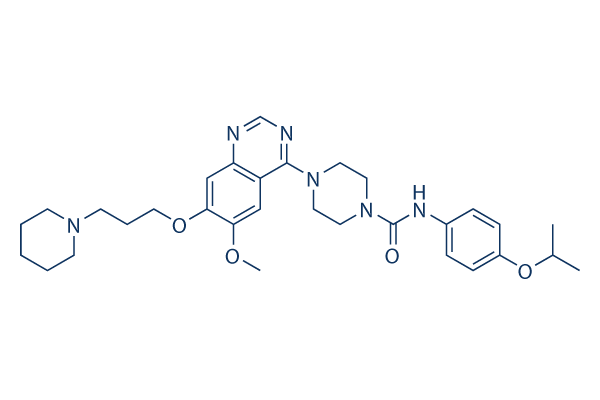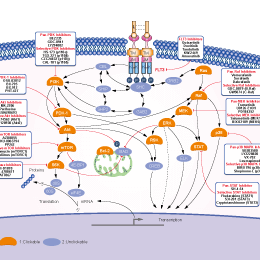
- Bioactive Compounds
- By Signaling Pathways
- PI3K/Akt/mTOR
- Epigenetics
- Methylation
- Immunology & Inflammation
- Protein Tyrosine Kinase
- Angiogenesis
- Apoptosis
- Autophagy
- ER stress & UPR
- JAK/STAT
- MAPK
- Cytoskeletal Signaling
- Cell Cycle
- TGF-beta/Smad
- DNA Damage/DNA Repair
- Compound Libraries
- Popular Compound Libraries
- Customize Library
- Clinical and FDA-approved Related
- Bioactive Compound Libraries
- Inhibitor Related
- Natural Product Related
- Metabolism Related
- Cell Death Related
- By Signaling Pathway
- By Disease
- Anti-infection and Antiviral Related
- Neuronal and Immunology Related
- Fragment and Covalent Related
- FDA-approved Drug Library
- FDA-approved & Passed Phase I Drug Library
- Preclinical/Clinical Compound Library
- Bioactive Compound Library-I
- Bioactive Compound Library-Ⅱ
- Kinase Inhibitor Library
- Express-Pick Library
- Natural Product Library
- Human Endogenous Metabolite Compound Library
- Alkaloid Compound LibraryNew
- Angiogenesis Related compound Library
- Anti-Aging Compound Library
- Anti-alzheimer Disease Compound Library
- Antibiotics compound Library
- Anti-cancer Compound Library
- Anti-cancer Compound Library-Ⅱ
- Anti-cancer Metabolism Compound Library
- Anti-Cardiovascular Disease Compound Library
- Anti-diabetic Compound Library
- Anti-infection Compound Library
- Antioxidant Compound Library
- Anti-parasitic Compound Library
- Antiviral Compound Library
- Apoptosis Compound Library
- Autophagy Compound Library
- Calcium Channel Blocker LibraryNew
- Cambridge Cancer Compound Library
- Carbohydrate Metabolism Compound LibraryNew
- Cell Cycle compound library
- CNS-Penetrant Compound Library
- Covalent Inhibitor Library
- Cytokine Inhibitor LibraryNew
- Cytoskeletal Signaling Pathway Compound Library
- DNA Damage/DNA Repair compound Library
- Drug-like Compound Library
- Endoplasmic Reticulum Stress Compound Library
- Epigenetics Compound Library
- Exosome Secretion Related Compound LibraryNew
- FDA-approved Anticancer Drug LibraryNew
- Ferroptosis Compound Library
- Flavonoid Compound Library
- Fragment Library
- Glutamine Metabolism Compound Library
- Glycolysis Compound Library
- GPCR Compound Library
- Gut Microbial Metabolite Library
- HIF-1 Signaling Pathway Compound Library
- Highly Selective Inhibitor Library
- Histone modification compound library
- HTS Library for Drug Discovery
- Human Hormone Related Compound LibraryNew
- Human Transcription Factor Compound LibraryNew
- Immunology/Inflammation Compound Library
- Inhibitor Library
- Ion Channel Ligand Library
- JAK/STAT compound library
- Lipid Metabolism Compound LibraryNew
- Macrocyclic Compound Library
- MAPK Inhibitor Library
- Medicine Food Homology Compound Library
- Metabolism Compound Library
- Methylation Compound Library
- Mouse Metabolite Compound LibraryNew
- Natural Organic Compound Library
- Neuronal Signaling Compound Library
- NF-κB Signaling Compound Library
- Nucleoside Analogue Library
- Obesity Compound Library
- Oxidative Stress Compound LibraryNew
- Plant Extract Library
- Phenotypic Screening Library
- PI3K/Akt Inhibitor Library
- Protease Inhibitor Library
- Protein-protein Interaction Inhibitor Library
- Pyroptosis Compound Library
- Small Molecule Immuno-Oncology Compound Library
- Mitochondria-Targeted Compound LibraryNew
- Stem Cell Differentiation Compound LibraryNew
- Stem Cell Signaling Compound Library
- Natural Phenol Compound LibraryNew
- Natural Terpenoid Compound LibraryNew
- TGF-beta/Smad compound library
- Traditional Chinese Medicine Library
- Tyrosine Kinase Inhibitor Library
- Ubiquitination Compound Library
-
Cherry Picking
You can personalize your library with chemicals from within Selleck's inventory. Build the right library for your research endeavors by choosing from compounds in all of our available libraries.
Please contact us at [email protected] to customize your library.
You could select:
- Antibodies
- Bioreagents
- qPCR
- 2x SYBR Green qPCR Master Mix
- 2x SYBR Green qPCR Master Mix(Low ROX)
- 2x SYBR Green qPCR Master Mix(High ROX)
- Protein Assay
- Protein A/G Magnetic Beads for IP
- Anti-Flag magnetic beads
- Anti-Flag Affinity Gel
- Anti-Myc magnetic beads
- Anti-HA magnetic beads
- Magnetic Separator
- Poly DYKDDDDK Tag Peptide lyophilized powder
- Protease Inhibitor Cocktail
- Protease Inhibitor Cocktail (EDTA-Free, 100X in DMSO)
- Phosphatase Inhibitor Cocktail (2 Tubes, 100X)
- Cell Biology
- Cell Counting Kit-8 (CCK-8)
- Animal Experiment
- Mouse Direct PCR Kit (For Genotyping)
- New Products
- Contact Us
Tandutinib (MLN518)
Synonyms: CT 53518, NSC726292, MLN518
Tandutinib (MLN518, CT53518, NSC726292) is a potent FLT3 antagonist with IC50 of 0.22 μM, also inhibits PDGFR and c-Kit, 15 to 20-fold higher potency for FLT3 versus CSF-1R and >100-fold selectivity for the same target versus FGFR, EGFR and KDR. Phase 2.

Tandutinib (MLN518) Chemical Structure
CAS No. 387867-13-2
Purity & Quality Control
Batch:
Purity:
99.88%
99.88
Tandutinib (MLN518) Related Products
| Related Targets | FLT3-WT FLT3-ITD FLT3-D835Y | Click to Expand |
|---|---|---|
| Related Products | Dovitinib (TKI-258) Dovitinib (TKI258) Lactate monohydrate KW-2449 ENMD-2076 UNC2025 AST-487 (NVP-AST487) TCS 359 FF-10101 G-749 SKLB4771 (FLT3-IN-1) AMG 925 | Click to Expand |
| Related Compound Libraries | Tyrosine Kinase Inhibitor Library PI3K/Akt Inhibitor Library Angiogenesis Related compound Library HIF-1 Signaling Pathway Compound Library FDA-approved Anticancer Drug Library | Click to Expand |
Signaling Pathway
Biological Activity
| Description | Tandutinib (MLN518, CT53518, NSC726292) is a potent FLT3 antagonist with IC50 of 0.22 μM, also inhibits PDGFR and c-Kit, 15 to 20-fold higher potency for FLT3 versus CSF-1R and >100-fold selectivity for the same target versus FGFR, EGFR and KDR. Phase 2. | ||||||||
|---|---|---|---|---|---|---|---|---|---|
| Targets |
|
| In vitro | ||||
| In vitro | Tandutinib has little activity against EGFR, FGFR, KDR, InsR, Src, Abl, PKC, PKA and MAPKs. Tandutinib inhibits IL-3-independent cell growth and FLT3-ITD autophosphorylation with an IC50 of 10-100 nM. Tandutinib also inhibits the proliferation of human leukemia Ba/F3 cells containing FLT3-ITD mutations with IC50 values of 10-30 nM, and the FLT3-ITD-positive Molm-13 and Molm-14 cells with an IC50 of 10 nM. In FLT3-ITD-positive Molm-14 cells but not the FLT3-ITD-negative THP-1 cells, Tandutinib treatment leads to significant apoptosis by 51% and 78% at 24 and 96 hours, respectively, due to specific FLT3 inhibition. [1] Tandutinib preferentially inhibits the growth of blast colonies from FLT3 ITD-positive compared with ITD-negative patients with AML, without affecting colony formation by normal human progenitor cells. [2] |
|||
|---|---|---|---|---|
| Kinase Assay | Cell based receptor autophosphorylation assays | |||
| Autophosphorylation of PDGFR family kinase assays are cell-based enzyme-linked immunosorbent (ELISA) assays using CHO cells expressing wild-type PDGFRβ, chimeric protein PDGFRβ/c-Kit, and PDGFRβ/Flt3 which contain the extracellular and transmembrane domains of PDGFRβ and the cytoplasmic domain of c-Kit, and Flt-3. Cells are grown to confluency in 96-well microtiter plates under standard tissue culture conditions, followed by serum starvation for 16 hours. Briefly, quiescent cells are incubated at 37 °C with increasing concentrations of Tandutinib for 30 minutes followed by the addition of 8 nM PDGF-BB for 10 minutes. Cells are lysed in 100 mM Tris, pH 7.5, 750 mM NaCl, 0.5% Triton X-100, 10 mM sodium pyrophosphate, 50 mM NaF, 10 μg/mL leupeptin, 1 mM phenylmethylsulfonyl fluoride, 1 mM sodium vanadate, and the lysate is cleared by centrifugation at 15,000g for 5 minutes. Clarified lysates are transferred into a second microtiter plate in which the wells are previously coated with 500 ng/well of 1B5B11 anti-PDGFRβ mAb and then incubated for 2 hours at room temperature. After washing three times with binding buffer (0.3% gelatin, 25 mM HEPES, pH 7.5, 100 mM NaCl, 0.01% Tween 20), 250 ng/mL of rabbit polyclonal anti-phosphotyrosine antibody is added and plates are incubated at 37 °C for 60 minutes. Subsequently, each well is washed three times with binding buffer and incubated with 1 μg/mL of horseradish peroxidase-conjugated anti-rabbit antibody at 37 °C for 60 minutes. Wells are washed prior to adding 2,2 | ||||
| Cell Research | Cell lines | Ba/F3, Molm-13, Molm-14, HL60, AML193, KG-1, KG-1a, THP-1, and RS4;11 | ||
| Concentrations | Dissolved in DMSO, final concentrations ~30 μM | |||
| Incubation Time | ~7 days | |||
| Method | Cells are exposed to increasing concentrations of Tandutinib (0.004-30 μM). Cells are grown for 3-7 days in tissue culture, and viable cells, determined by Trypan blue dye exclusion, are counted. At daily intervals, cells are harvested, washed, and resuspended in 100 uL binding buffer containing 10 mM HEPES (pH 7.4), 140 mM NaCl, and 2.5 mM CaCl2. Annexin V-FITC (100 ng) and propidium iodide (250 ng) are added to the cell suspension followed by incubation at room temperature for 15 minutes. Flow cytometry is performed immediately after staining on a FACSort flow cytometer with excitation at 488 nm. Fluorescence of annexin V-FITC and DNA propidium iodide staining are measured at 515 nm and 585 nm, respectively. |
|||
| In Vivo | ||
| In vivo | Oral administration of Tandutinib at 60 mg/kg bid significantly increases the survival in mice bearing Ba/F3 cells expressing W51 FLT3-ITD mutant, and gives a significant reduction in mortality in a mouse bone marrow transplantation model. [1] Tandutinib treatment at 180 mg/kg twice daily has mild toxicity toward normal hematopoiesis, however, it is a dose at which Tandutinib is effective in treating FLT3 ITD-positive leukemia in mice. [2] |
|
|---|---|---|
| Animal Research | Animal Models | Female athymic nude (nu/nu) mice injected with Ba/F3 cells expressing W51 FLT3-ITD mutant |
| Dosages | 40-120 mg/kg/day | |
| Administration | Orally by gavage | |
| NCT Number | Recruitment | Conditions | Sponsor/Collaborators | Start Date | Phases |
|---|---|---|---|---|---|
| NCT00904852 | Withdrawn | Glioblastoma Multiforme |
Millennium Pharmaceuticals Inc. |
June 2009 | Phase 1 |
Chemical Information & Solubility
| Molecular Weight | 562.7 | Formula | C31H42N6O4 |
| CAS No. | 387867-13-2 | SDF | Download Tandutinib (MLN518) SDF |
| Smiles | CC(C)OC1=CC=C(C=C1)NC(=O)N2CCN(CC2)C3=NC=NC4=CC(=C(C=C43)OC)OCCCN5CCCCC5 | ||
| Storage (From the date of receipt) | |||
|
In vitro |
Ethanol : 100 mg/mL DMSO : 35 mg/mL ( (62.2 mM) Moisture-absorbing DMSO reduces solubility. Please use fresh DMSO.) Water : Insoluble |
Molecular Weight Calculator |
|
In vivo Add solvents to the product individually and in order. |
In vivo Formulation Calculator |
||||
Preparing Stock Solutions
Molarity Calculator
In vivo Formulation Calculator (Clear solution)
Step 1: Enter information below (Recommended: An additional animal making an allowance for loss during the experiment)
mg/kg
g
μL
Step 2: Enter the in vivo formulation (This is only the calculator, not formulation. Please contact us first if there is no in vivo formulation at the solubility Section.)
% DMSO
%
% Tween 80
% ddH2O
%DMSO
%
Calculation results:
Working concentration: mg/ml;
Method for preparing DMSO master liquid: mg drug pre-dissolved in μL DMSO ( Master liquid concentration mg/mL, Please contact us first if the concentration exceeds the DMSO solubility of the batch of drug. )
Method for preparing in vivo formulation: Take μL DMSO master liquid, next addμL PEG300, mix and clarify, next addμL Tween 80, mix and clarify, next add μL ddH2O, mix and clarify.
Method for preparing in vivo formulation: Take μL DMSO master liquid, next add μL Corn oil, mix and clarify.
Note: 1. Please make sure the liquid is clear before adding the next solvent.
2. Be sure to add the solvent(s) in order. You must ensure that the solution obtained, in the previous addition, is a clear solution before proceeding to add the next solvent. Physical methods such
as vortex, ultrasound or hot water bath can be used to aid dissolving.
Tech Support
Answers to questions you may have can be found in the inhibitor handling instructions. Topics include how to prepare stock solutions, how to store inhibitors, and issues that need special attention for cell-based assays and animal experiments.
Tel: +1-832-582-8158 Ext:3
If you have any other enquiries, please leave a message.
* Indicates a Required Field
Tags: buy Tandutinib (MLN518) | Tandutinib (MLN518) supplier | purchase Tandutinib (MLN518) | Tandutinib (MLN518) cost | Tandutinib (MLN518) manufacturer | order Tandutinib (MLN518) | Tandutinib (MLN518) distributor







































